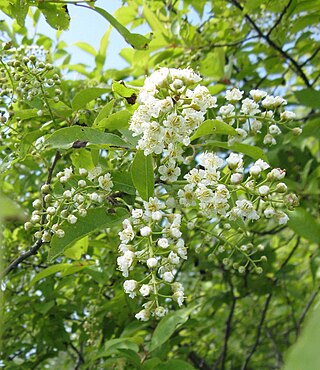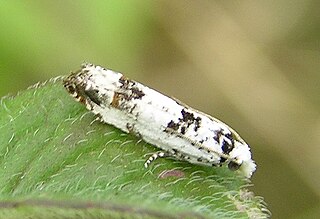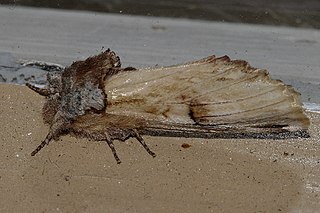
Prunus virginiana, commonly called bitter-berry, chokecherry, Virginia bird cherry, and western chokecherry, is a species of bird cherry native to North America.

The Lymantriinae are a subfamily of moths of the family Erebidae. The taxon was erected by George Hampson in 1893.

Polyhymno is a genus of moths in the family Gelechiidae.

Eucosma is a very large genus of moths belonging to the family Tortricidae. Some taxonomies place a number of species in the genus Eucopina. The genus has a Holarctic and Indomalayan distribution. Even in well-studied Europe and North America, new species are still regularly discovered. There are at least 670 described species in Eucosma worldwide.

The Thyatirinae, or false owlet moths, are a subfamily of the moth family Drepanidae with about 200 species described. Until recently, most classifications treated this group as a separate family called Thyatiridae.

Laelia is a genus of tussock moths in the family Erebidae. The genus was described by Stephens in 1828. Species are well distributed throughout Europe, Japan, China, India, Sri Lanka, Myanmar and Java.
Xerodes is a genus of moths in the family Geometridae first described by Achille Guenée in 1857.

Oligocentria semirufescens, the red-washed prominent moth or rusty prominent, is a moth of the family Notodontidae. The species was first described by Francis Walker in 1865. It is found in North America from Nova Scotia west to Vancouver Island, south to Florida, Colorado and central California.
Hyposmocoma lignicolor is a species of moth of the family Cosmopterigidae. It was first described by Lord Walsingham in 1907. It is endemic to the Hawaiian island of Maui. The type locality is Haleakalā, a massive shield volcano where it was collected at an altitude of 5,000 feet (1,500 m).

Oligocentria is a genus of moths in the family Notodontidae, the prominents.
BugGuide is a website and online community of naturalists, both amateur and professional, who share observations of arthropods such as insects, spiders, and other related creatures. The website consists of informational guide pages and many thousands of photographs of arthropods from the United States and Canada which are used for identification and research. The non-commercial site is hosted by the Iowa State University Department of Entomology. BugGuide was conceived by photographer Troy Bartlett in 2003 and since 2006 has been maintained by John VanDyk, an adjunct assistant professor of entomology and a senior systems analyst at Iowa State University. The website has been recognized for helping change the public perception of insects.
Polyhymno lignicolor is a moth of the family Gelechiidae. It was described by Anthonie Johannes Theodorus Janse in 1950. It is found in the South African province of Gauteng.
Oligocentria pinalensis, the Arizona prominent, is a moth of the family Notodontidae. It is only found within the Pinal Mountains of central Arizona. Due to its extremely limited known range, Oligocentria pinalensis is at a high risk of becoming extinct from isolated events, such as a forest fire. There is not enough current population data to make a full conclusion of its present status. Although it has been listed by the NatureServe conservation status as "GH" or possibly extinct, date of listing of status was 2002. The species was first described by F.H. Benjamin, a pan-pacific entomologist, in a publication from 1932.
Oligocentria delicata is a species of moth in the family Notodontidae. It was first described by Harrison Gray Dyar Jr. in 1905 and it is found in North America.

Oligocentria pallida, the pale prominent, is a species of moth in the family Notodontidae. It was first described by Strecker in 1899 and it is found in North America.
Oligocentria paradisus is a species of moth in the family Notodontidae. It was first described by Foster Hendrickson Benjamin in 1932 and it is found in North America.

Emily L. Morton was an American entomologist and scientific illustrator. She was a co-author at onset of The Life-Histories of the New York Slug Caterpillars series.

A MONA number, or Hodges number after Ronald W. Hodges, is part of a numbering system for North American moths found north of Mexico in the Continental United States and Canada, as well as the island of Greenland. Introduced in 1983 by Hodges through the publication of Check List of the Lepidoptera of America North of Mexico, the system began an ongoing numeration process in order to compile a list of the over 12,000 moths of North America north of Mexico. The system numbers moths within the same family close together for identification purposes. For example, the species Epimartyria auricrinella begins the numbering system at 0001 while Epimartyria pardella is numbered 0002.












